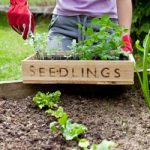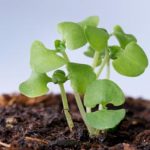
Gardener holding wooden seedling tray in vegetable garden.
How to Choose the Right Seeds for Your Garden
Starting a garden begins with a simple yet crucial decision: choosing the right seeds/plants. Whether you’re planning a vegetable garden, a cut-flower bed, or a mix of both, selecting seeds suited to your climate, growing season, and gardening goals will set you up for success.
Understanding Cool-Season vs. Warm-Season Seeds
One of the most important factors when selecting seeds is whether they thrive in cool or warm weather. Choosing the right type for the time of year and your region will ensure healthier plants and better harvests. Since we live in Maryland we have our cool season which runs from march to May and then our warm season may- august followed by another cool August to October. This means you can grow multiple crops in small areas!
Cool-Season Seeds
Cool-season plants prefer mild temperatures and can tolerate light frosts. They often grow best when sown in early spring or late summer to fall. Many cool-season vegetables have sweeter flavors when grown in cool weather, and some flowers bloom best in spring or fall.
✔ Best Cool-Season Vegetables:
- Leafy Greens: Lettuce, spinach, kale, arugula
- Root Crops: Carrots, beets, radishes, turnips
- Brassicas: Broccoli, cauliflower, cabbage, Brussels sprouts
- Legumes: Peas, fava beans
- Other: Onions, garlic
✔ Best Cool-Season Flowers:
- Pansies & Violas – Cold-hardy and bloom early in spring
- Snapdragons – Thrive in cooler temperatures and can handle frost
- Larkspur – Can be sown in fall for early spring blooms
- Sweet Peas – Prefer cool weather and produce fragrant blooms
- Calendula – Edible flowers that bloom in cool conditions
🌱 When to Plant Cool-Season Seeds:
- Indoors: Start seeds 6–8 weeks before your last frost date for early transplanting.
- Direct Sow: As soon as the ground is workable in spring or in late summer for a fall crop.
Warm-Season Seeds
Warm-season plants require consistently warm temperatures to thrive. They are typically planted after the last frost and need plenty of sunlight to produce fruit and flowers. Many warm-season vegetables are heavy feeders, benefiting from rich soil and regular watering.
✔ Best Warm-Season Vegetables:

Father And Son Planting Seedling In Ground On Allotment
- Fruit-Bearing Crops: Tomatoes, peppers, eggplant
- Vining Vegetables: Cucumbers, squash, melons
- Beans & Corn: Green beans, pole beans, sweet corn
- Root Crops: Sweet potatoes, peanuts
✔ Best Warm-Season Flowers:
- Zinnias – Heat-tolerant and provide continuous blooms
- Sunflowers – Thrive in full sun and attract pollinators
- Marigolds – Help repel pests and bloom all season
- Cosmos – Low-maintenance flowers that love the heat
- Nasturtiums – Edible flowers that deter pests in vegetable gardens
🌞 When to Plant Warm-Season Seeds:
- Indoors: Start seeds indoors 6–10 weeks before your last frost date to get a head start.
- Direct Sow: After the danger of frost has passed and soil temperatures are consistently warm (typically 60°F+).
How to Choose the Best Seeds for Your Garden
Once you understand the difference between cool-season and warm-season plants, you can narrow down your options based on your garden’s needs.
1. Consider Your Growing Zone & Frost Dates
We are zone 6/7 and our average last frost date is May 1 ( we often recommend May 10 as true safe date) will help you determine which seeds to start early indoors and which can be sown directly outdoors. Check out this sowing when guide. You can also check seed packets for recommended planting times based on your region.
2. Choose Between Heirloom, Hybrid & Organic Seeds
- Heirloom Seeds – Open-pollinated and saved for generations, offering unique flavors and colors.
- Hybrid Seeds – Bred for disease resistance, higher yields, and uniformity.
- Organic Seeds – Grown without synthetic chemicals, ideal for organic gardening.
Choosing between heirloom and hybrid seeds depends on your gardening goals. Heirloom seeds are open-pollinated varieties that have been passed down for generations, valued for their rich flavors, unique colors, and the ability to save seeds for future planting. They are ideal for gardeners who want to preserve genetic diversity, grow traditional crops, and enjoy produce with superior taste. However, heirlooms can sometimes be more susceptible to pests and diseases. Hybrid seeds, on the other hand, are selectively bred to enhance traits like disease resistance, higher yields, and uniform growth. They are a great choice if you want reliable production, better resistance to environmental stress, or a garden with fewer pest issues. However, hybrid seeds do not produce true-to-type plants if saved and replanted. If you prioritize sustainability and seed saving, heirlooms are the way to go. If you need consistency and resilience, hybrids might be the better option.
3. Decide If You Want Direct Sowing or Transplants
Some seeds, like root crops (carrots, beets, radishes) and beans, prefer to be direct sown in the garden. Others, like tomatoes, peppers, and many flowers, benefit from starting indoors and transplanting later.
4. Factor in Your Garden Space & Growing Time
If you have limited space, choose compact or container-friendly varieties. If your growing season is short, look for fast-maturing plants like bush beans, baby greens, or dwarf sunflowers.
5. Pick Seeds Based on Your Garden Goals
- Want a kitchen garden? Focus on high-yield vegetables like lettuce, tomatoes, and herbs.
- Looking for pollinator-friendly plants? Include zinnias, cosmos, and native wildflowers.
- Planning a cut-flower garden? Grow long-stemmed flowers like snapdragons, larkspur, and sunflowers.
Final Thoughts: The Right Seeds for a Thriving Garden
Choosing the right seeds is the foundation of a successful garden. By selecting cool-season crops for early spring and fall, and warm-season crops for summer, you can enjoy a continuous harvest of vegetables and flowers throughout the year.
Take the time to read seed packets, consider your climate, and align your choices with your gardening goals. With a little planning, you’ll be on your way to a thriving, productive garden!
💡 Ready to start planting? Browse our selection of vegetable and flower seeds to get growing today!






